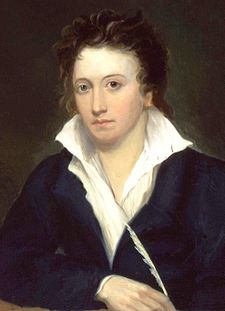Poet Percy
Bysshe Shelley died on July 8, 1822 in a ship wreck off of the coast of Italy. He
was born on August 4, 1792 near Horsham in Sussex. His father was a member of
parliament and young Shelley was educated at Eton and at Oxford University.
There he began to read radical writers such as Tom Paine and William Godwin. In
1811, he was expelled for his contribution to a pamphlet supporting atheism.
Shelley
then eloped to Scotland with 16-year-old Harriet Westbrook. The resulting
scandal caused a serious rift with his family. Harriet and Shelley had two
children, but soon separated. In 1813, Shelley published his first serious
work, Queen Mab.
In 1814,
Shelley fell in love with Mary, the 16-year-old daughter of writers William
Godwin (a friend of Shelley's) and Mary Wollstonecraft. The couple traveled
together in Europe and spent the summer of 1816 at Lake Geneva with Lord Byron.
Shelley wrote poetry and Mary conceived the idea for her novel Frankenstein. In December 1816, Shelley
and Mary were married; just a few weeks after Harriet had drowned herself. In
1818, Shelley took his family to Italy where they moved from city to city. Two
of the Shelley's children died and Mary herself suffered a nervous breakdown.
Nonetheless, this was the most productive period of his life. Poems included Prometheus Unbound (1818-19) and Adonais (1821), inspired by the death of
his friend and fellow poet John Keats. In April 1822, the Shelley’s settled on
the Bay of Lerici on the north-western Italian coast. On July 8th, Shelley
was returning from visiting his friends Lord Byron and James Leigh Hunt when
his boat overturned and he was drowned. He was cremated and his ashes were
buried at the Protestant Cemetery in Rome, where Keats was also buried.
Michael Thomas Barry is the author of Literary
Legends of the British Isles. The book can be purchased from Amazon
through the following links:



No comments:
Post a Comment